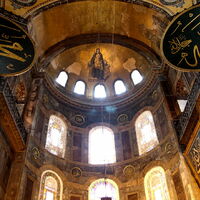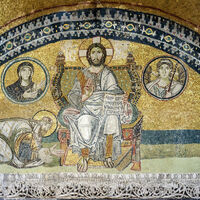Hagia Sophia in Constantinople
Date:
Originally built in the mid-fourth century; rebuilt from 532 to 537 with additions in subsequent centuries
Location or Findspot (Modern-Day Country):
Turkey
Description:
Emperor Justinian was the patron of a great domed church dedicated to Holy Wisdom, Hagia Sophia, after an older Hagia Sophia burned down in 532. The new church was built from 532 to 537 with Justinian's financial support and the architectural expertise of its designers, Anthemios of Tralles and Isidore of Miletus. It served as Constantinople's cathedral and the site of imperial ceremonies. After the dome collapsed in the 550s, it was rebuilt with a taller profile to channel its weight downward rather than outward (there were partial dome collapses in the tenth and fourteenth centuries).
The clergy, accompanied at times by the emperor, processed through the imperial door (topped by finger-shaped curtain hooks into the naos and toward the projecting apse. A poem delivered during the consecration of Hagia Sophia in the sixth century noted that it contained "a wealth of porphyry . . . powdered with bright stars." In addition to its use on walls, porphyry disks were inserted into the cathedral's marble floor to mark where someone important should stand during the liturgies.
The original sixth-century mosaic decoration was nonfigural, with geometric and gem-like patterns on a gold or silver ground. Mosaics added in subsequent periods reflect moments of historical change and imperial patronage. Several ninth-century mosaics are associated with the restoration of image veneration after the end of Byzantine iconoclasm in 843. These include an emperor, whose identity is uncertain, in proskynesis before the enthroned Christ (ca. 840 or ca. 870). This scene appears in the lunette over the imperial door. The apse mosaic, commissioned by Basil I (r. 867–886), is also associated with the end of iconoclasm. The Theotokos and Child, set against the gold tesserae of the apse, appear accompanied by archangels in the soffit of the vault.
Other additions offer evidence of subsequent emperors and empresses continuing to act as patrons. The ninth-century bronze doors at the southwest end of the narthex are marked with monograms (interwoven letters that represent individuals' names) and invocations to Christ and Mary. In the eleventh century, a new mosaic was added to the east wall of the south gallery with Christ between an imperial couple. On one side is the empress Zoe (r. 1028–50; her inscription reads "Zoe, the most pious Augusta") and on the other is the emperor, whose identity changed over time as Zoe remarried. In the twelfth century, a mosaic of Emperor John II Komnenos (r. 1118–43) and Empress Eirene flanking the Theotokos appeared in a mosaic near that of Zoe and her husband.
After the period of Latin occupation, a Deesis mosaic in the south gallery was likely commissioned by Emperor Michael VIII Palaiologos (r. 1261–82), who followed the example of his Orthodox predecessors. The church continued to be embellished with mosaics into the fourteenth century.
The clergy, accompanied at times by the emperor, processed through the imperial door (topped by finger-shaped curtain hooks into the naos and toward the projecting apse. A poem delivered during the consecration of Hagia Sophia in the sixth century noted that it contained "a wealth of porphyry . . . powdered with bright stars." In addition to its use on walls, porphyry disks were inserted into the cathedral's marble floor to mark where someone important should stand during the liturgies.
The original sixth-century mosaic decoration was nonfigural, with geometric and gem-like patterns on a gold or silver ground. Mosaics added in subsequent periods reflect moments of historical change and imperial patronage. Several ninth-century mosaics are associated with the restoration of image veneration after the end of Byzantine iconoclasm in 843. These include an emperor, whose identity is uncertain, in proskynesis before the enthroned Christ (ca. 840 or ca. 870). This scene appears in the lunette over the imperial door. The apse mosaic, commissioned by Basil I (r. 867–886), is also associated with the end of iconoclasm. The Theotokos and Child, set against the gold tesserae of the apse, appear accompanied by archangels in the soffit of the vault.
Other additions offer evidence of subsequent emperors and empresses continuing to act as patrons. The ninth-century bronze doors at the southwest end of the narthex are marked with monograms (interwoven letters that represent individuals' names) and invocations to Christ and Mary. In the eleventh century, a new mosaic was added to the east wall of the south gallery with Christ between an imperial couple. On one side is the empress Zoe (r. 1028–50; her inscription reads "Zoe, the most pious Augusta") and on the other is the emperor, whose identity changed over time as Zoe remarried. In the twelfth century, a mosaic of Emperor John II Komnenos (r. 1118–43) and Empress Eirene flanking the Theotokos appeared in a mosaic near that of Zoe and her husband.
After the period of Latin occupation, a Deesis mosaic in the south gallery was likely commissioned by Emperor Michael VIII Palaiologos (r. 1261–82), who followed the example of his Orthodox predecessors. The church continued to be embellished with mosaics into the fourteenth century.
Relevant Textbook Chapter(s):
3,
5,
6,
7,
9,
11
Repository and Online Resources:
• Explore Hagia Sophia in a 360-degree video from the BBC.
• Watch a video on how Byzantine mosaics were created.
• Listen to Prof. Robert Ousterhout's webinar on "Hagia Sophia: The History of the Building and the Building in History"
• Listen to Prof. Bissera Pentcheva's webinar on "The Concept and Experience of Holy Wisdom in Hagia Sophia"
Image Credits:
Wikimedia Commons, Giovanni Gasbarri, Navid Jamali













